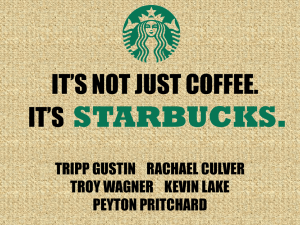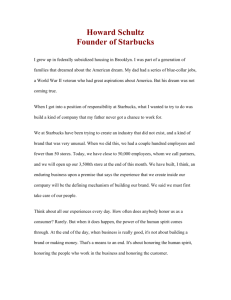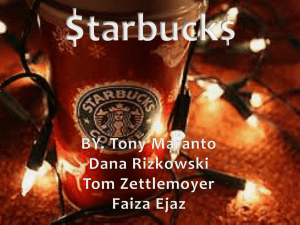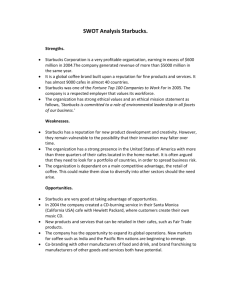STARBUCKS' OWN GOOD IDEA
advertisement
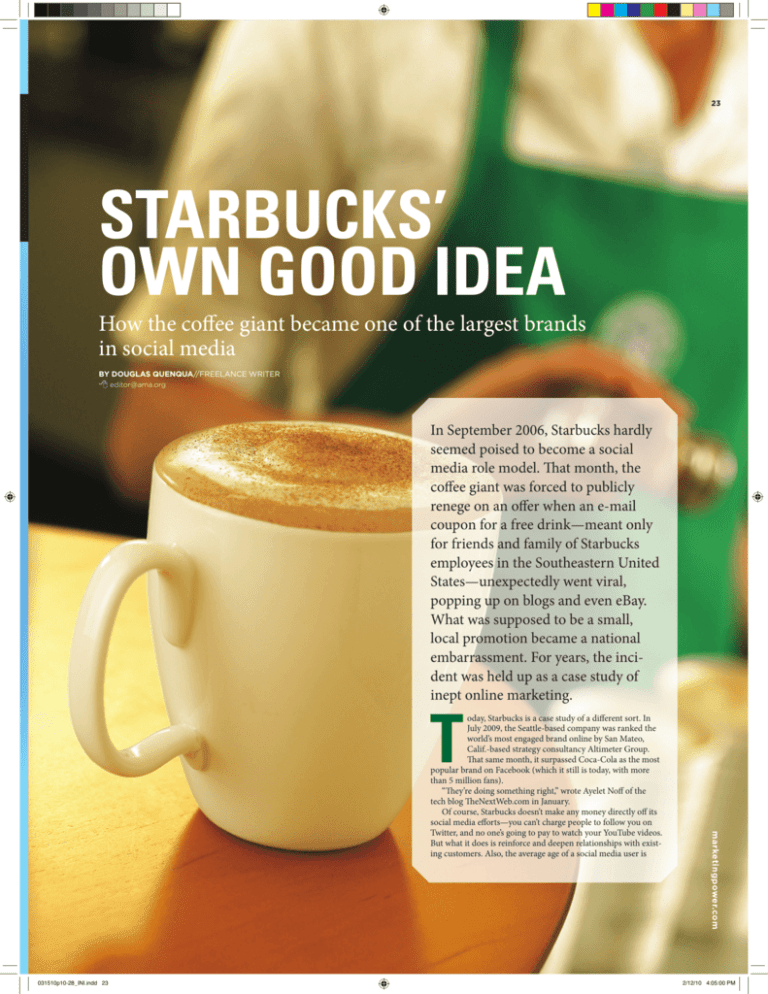
23 STARBUCKS’ OWN GOOD IDEA How the coffee giant became one of the largest brands in social media BY DOUGLAS QUENQUA//FREELANCE WRITER editor@ama.org In September 2006, Starbucks hardly seemed poised to become a social media role model. That month, the coffee giant was forced to publicly renege on an offer when an e-mail coupon for a free drink—meant only for friends and family of Starbucks employees in the Southeastern United States—unexpectedly went viral, popping up on blogs and even eBay. What was supposed to be a small, local promotion became a national embarrassment. For years, the incident was held up as a case study of inept online marketing. T 031510p10-28_INI.indd 23 marketingpower.com oday, Starbucks is a case study of a different sort. In July 2009, the Seattle-based company was ranked the world’s most engaged brand online by San Mateo, Calif.-based strategy consultancy Altimeter Group. That same month, it surpassed Coca-Cola as the most popular brand on Facebook (which it still is today, with more than 5 million fans). “They’re doing something right,” wrote Ayelet Noff of the tech blog TheNextWeb.com in January. Of course, Starbucks doesn’t make any money directly off its social media efforts—you can’t charge people to follow you on Twitter, and no one’s going to pay to watch your YouTube videos. But what it does is reinforce and deepen relationships with existing customers. Also, the average age of a social media user is 2/12/10 4:05:00 PM OOOOOOO Digital Issue 24 Alex Wheeler, director of digital strategy considerably younger than most people buying coffee today, which means Starbucks is hopefully generating “fans” through social media who will one day morph into lifelong customers. Much of what makes Starbucks successful on social media platforms is by now familiar: The company uses Twitter, Facebook and its blogs to listen more than talk; it creates a sense of community through one-on-one interactions; and it doesn’t shy away from engaging the brand’s fans and critics alike. Alex Wheeler, director of digital strategy for the Seattle-based chain, says the company’s approach to digital media has less to do with lessons it learned from runaway e-mail messages than with trying to replicate the coffeehouse experience online. “We don’t think about it as just a marketing or public relations channel,” Wheeler says. “This is about [answering the question of] how do we extend the very strong customer experience that we deliver every day in our stores into these other really relevant spaces?” Reggie Bradford, founder and CEO of Vitrue, an Atlanta, Ga.-based social-media management company, says that strategy has paid off. Starbucks ranked No. 11 in Vitrue’s Top 100 Social Brands of 2009. “I think what they’ve done is elevate the entire experience away from just a cup of coffee into, really, Starbucks being the corner bar, and they’ve used social media to leverage that positioning,” he says. Starbucks maintains four primary digital touch points: A Facebook page, which it uses to communicate with fans internationally A Twitter feed, which serves largely as a customer service channel A YouTube channel, where the company posts videos ranging from branded content to short documentaries of its charitable work MyStarbucksIdea.com, a digital suggestion box where customers can submit their ideas for products or services. 031510p10-28_INI.indd 24 “I think what they’ve done is elevate the entire experience away from just a cup of coffee into, really, Starbucks being the corner bar, and they’ve used social media to leverage that positioning,” Reggie Bradford, founder and CEO of Vitrue myStarbucks App display Wheeler, a Seattle native who has childhood memories of the original Starbucks in Pike Place Market, declined to say how much Starbucks spends on social media every year. While not breaking marketing spending out by sector, Starbucks Chief Financial Officer Troy Alstead did note in a January earnings call that investors should expect “significant marketing increases” in the coming year. Wheeler does note that social media was a growing percentage of the company’s marketing budget. Just how big is anyone’s guess, but she offers a clue by quoting a colleague’s favorite saying about ROI: “Keep the ‘I’ so small that no one asks about the ‘R,’ ” she laughs. Besides, she says, “as far as the developing and engaging and managing of communities online” there are “much more important resources than financial.” Those resources, of course, are the people. Wheeler leads a team of 13 staffers devoted entirely to digital. (Her group rolls up into the marketing department.) One key to the Starbuck’s social media experience is that all those staffers are deputized to interact with customers online directly. And while the company does use outside agencies to monitor its platforms and metrics—Blast Radius in Vancouver is its digital agency; Omnicom Group’s BBDO is its creative ad firm—no one from those agencies is interacting with customers on Starbucks’ behalf. “One of the things we are diehard about is that engagement in these channels has to come from a Starbucks partner,” Wheeler says. (Starbucks refers to all its employees as partners.) Even with its success on Twitter (more than 700,000 followers) and Facebook, the heart of Starbuck’s social media efforts is MyStarbucksIdea.com, where customers can actually influence what products the company offers. “When you work for Starbucks, you can’t go to a dinner party or sit on a plane without people first getting really excited like, ‘Oh, I love Starbucks!’ ” she says, “but then followed by, ’You know what you guys should do?’ So it was really, I think, the right point of entry for many reasons.” MyStarbucksIdea.com launched in March 2008. Since then, more than 180,000 customers have registered, and more than 80,000 suggestions have been submitted. So far, 50 of those ideas—from bringing back the Yukon Blend to creating an iPhone app—have been implemented. There is also a restricted section of the site where employees can make suggestions. The key insight that makes MyStarbucksIdea a success also informs its use of Twitter, says Brad Nelson, the product manager who runs the company’s Twitter and Facebook feeds. “In many ways, customer service is the new marketing,” he says. “If you can help somebody solve a problem, they’ll tell their friend, and then they’ll tell their friends. That’s a great way for word of mouth to spread.” Indeed, it’s the same approach that has won high praise for companies like Zappos and JetBlue. Of course, a company doesn’t get to be as successful and ubiquitous as Starbucks without attracting some critics. Many of these critics use social media like Twitter to broadcast their grievances. Nelson will occasionally engage them but says experience has taught him who to engage—and who not to. 2/12/10 4:24:13 PM 25 “There are negative people who are being reasonable and you can have a conversation with them, and these types of people we’ll engage,” he says. “If they’re not being reasonable and just yelling, we won’t engage them.” For example, last May Nelson began Tweeting with a particularly negative blogger, eventually setting up a phone call with the company’s director of ethical sourcing. That blogger then wrote a post titled “Starbucks, I done you wrong!” Starbucks’ online success comes at a time of transition for the company. In 2009, cashstrapped consumers traded down from $4 lattes to home-brewed coffees made with lesspremium beans. Starbucks also began to feel the pinch of its rapid expansion throughout the previous decade and was forced to close hundreds of stores worldwide. There were 8,832 Starbucks stores around the world as of September 2009, down from 9,217 a year earlier. Revenue for 2009 dipped 6%, to $9.8 billion from $10.4 billion in 2008. First quarter earnings released in January delivered better news: Same-store sales were up 4%, the first gain in two years; however, in an earnings call Starbucks CEO Howard Schultz reiterated that the environment was still extremely uncertain. Success in social media hardly guarantees offline profits, but Vitrue’s Bradford points out an interesting result of all that social media chatter: The word “Starbucks” is now mentioned on social media 10 times more often than the word “coffee.” In other words, the brand has, in many ways, eclipsed its own product. “They are now the Kleenex of the category,” Bradford says. m Find Out More @ MarketingPower.com Articles: Money Talks: Social Media-Savvy Companies Ratchet Up Revenue Sweet on Tweets: Leveraging Twitter to Drive Brand Results A Group Effort To Serve Customers, Understand Them From Social to Super Brands: Building Brands in the Digital Age Events: Advance Social Media Training Series April 13-14, Philadelphia Digital Centered Marketing Spotlight April 15, New York Webcasts: Driving Customer Growth in a Social Economy A Focus Group of Millions: Leveraging Social Media for Consumer Insights Douglas Quenqua is a freelance writer in Brooklyn, N.Y. 031510p10-28_INI.indd 25 2/12/10 4:05:40 PM



